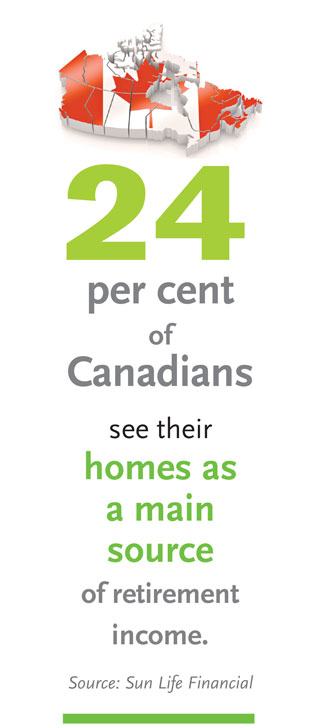By the Chartered Professional Accountants of Ontario
 Close to 11 million Canadians—60 per cent of the workforce—do not have access to a workplace pension plan, according to the Canadian Association of Retired Persons (CARP Canada).
Close to 11 million Canadians—60 per cent of the workforce—do not have access to a workplace pension plan, according to the Canadian Association of Retired Persons (CARP Canada).
“After years of steadily increasing real-estate prices, many individuals’ largest retirement asset may be their home,” says Irwin Chovela (CPA, CA), partner with Shimmerman Penn LLP in Toronto. “It’s likely that many will want to leverage the equity they’ve built up in their homes as a source of cash flow.”
There are many ways people can access this equity, such as selling their home and downsizing to a cheaper one, or even renting. This is an approach that enables individuals to extract some of the value in their house without incurring additional debt.
“Some people’s retirement dream involves moving to a smaller house away from the city,” says Paul Morton (CPA, CA) of Ottawa’s Ginsberg Gluzman Fage & Levitz LLP. “But others might not want to move away from family. For them, the benefits of downsizing can be less, especially given that even smaller condos in cities have become quite expensive.”
For retirees who are determined to stay in their homes, what other options are there? Let’s take a closer look. Two of the most popular choices are either: a traditional line of credit or a reverse mortgage. Both are designed to allow homeowners to borrow against their home equity.
Line of credit
A line of credit is a tool for borrowing, where the lender offers the borrower a limit and an interest rate; the limit is determined by the bank’s perception of the borrower’s ability to pay the loan back. Before proceeding with a line of credit, seniors need to consider whether they are able to sustain the debt associated with borrowing on a line of credit over the longer term. If, for example, they live longer than the average person, this would mean carrying the debt for a more extended period of time.
Reverse mortgage
Individuals older than 55 years of age might be eligible for a reverse mortgage, which allows them access to up to 50 per cent of their home’s value. The actual amount obtainable through a reverse mortgage depends on the appraised value of the house and the ages of the homeowner and his or her spouse. As long as the homeowners continue to live in that house, they aren’t required to make any principal or interest payments. The reverse mortgage comes due when the home is sold; the last surviving homeowner dies; or the homeowners no longer permanently reside in the home.
“Reverse mortgages are primarily designed so seniors can avoid the turmoil and upset of being forced to move out of a home they can no longer afford and find other accommodation,” says Chovela. “Once they receive the funds, there are no restrictions on how the homeowner uses the money, except when there is a pre-existing mortgage or a secured line of credit on the house, in which case those debts must be retired first with the funds received from the reverse mortgage.”
For more information, visit the website of the Chartered Professional Accountants of Ontario at www.icao.on.ca.













